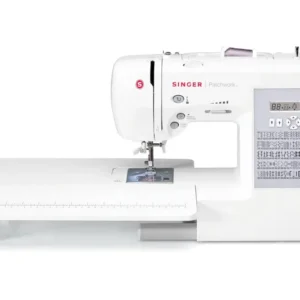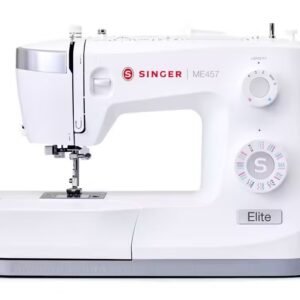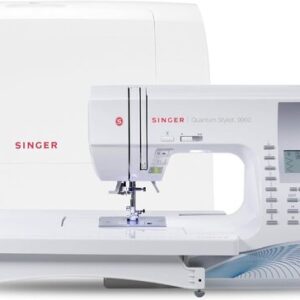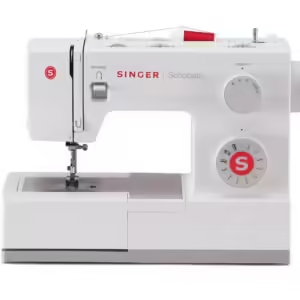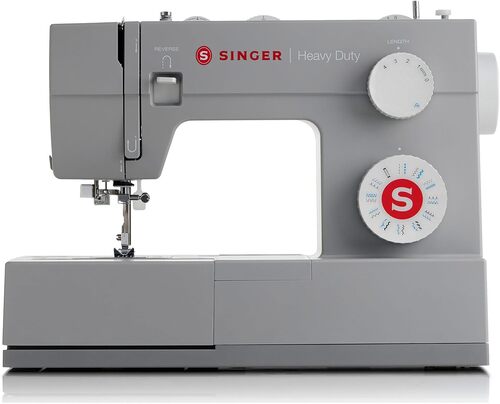
I still remember the night I finally hit “Buy Now” on the Singer Heavy Duty 4423.
Weeks of scrolling through Singer Heavy Duty 4423 reviews and YouTube demos had left me both dazzled by its power and scared of the horror stories about bird-nested bobbins and runaway foot pedals. But my thirty-year-old thrift-store machine had just snapped a needle on a pair of jeans, and my side-hustle sewing dog-collar orders was piling up – so the 4423 became my gamble.
Unboxing jitters
The gray chassis looked tougher than the plastic clamshells I’d handled before, yet it weighed only about fifteen pounds – perfect for dragging from kitchen table to closet. Inside the “secret” accessory tray I found four clear class-15 bobbins, a zipper foot and even a pack of size 90/14 needles. The first snag? The quick-start sheet was thinner than a pattern tissue. I grabbed my phone, searched “Singer 4423 review threading” and followed the numbered path printed on the machine. Ten minutes later a royal-blue thread was dancing through the eye, and the drop-in bobbin clicked into place.
First stitches – love at first roar
People online weren’t kidding: the 4423 is fast. One feather-light tap on the pedal and it leapt from zero to warp speed. I practiced on muslin, then fed two layers of denim under the presser foot. Thud-thud-thud – the motor hardly flinched. The stitches on top were straight as railroad tracks; the bottom looked just as clean. My confidence shot up.
The honeymoon hiccup
Day three, disaster struck. While top-stitching a canvas tote, the needle jammed, the hand-wheel froze and a snarl of red thread mushroomed under the fabric. I almost boxed the machine up – but a commenter in a Singer Heavy Duty 4423 reviews thread had warned: “If you skip guide #5, you’ll pay.” Sure enough, the thread had slipped out. I re-threaded, dropped a dab of oil into the hook race, and the 4423 purred again. Lesson learned: this machine is bullet-proof only when you respect its threading path.
Putting it to work
Month 1 – Cornhole bags: Eight layers of duck cloth plus resin pellets? Slow start with a 110/18 needle, then full throttle. No broken needles, no skipped stitches.
Month 4 – Jeans marathon: Hemmed five pairs, belt-loop bumps included. I tied a brick to the foot pedal cord – cheap fix for that too-short lead everyone complains about.
Month 7 – Holiday rush: Cranked out forty nylon-webbing dog collars. Heavy-duty #69 thread on top, standard poly in the bobbin, tension at 7. Still flying.
Year 2 – Quilted throw: Finally tested the one-step buttonhole and the handful of decorative stitches. Limited, but crisp enough for a homespun vibe.
What I tell friends now
Pros:
- Motor muscle: it chews through denim seams and vinyl straps my old machine feared.
- Beginner friendly: numbered threading path, drop-in bobbin window, built-in needle threader (after a small tweak with tweezers).
- Price vs. payoff: for under two hundred bucks it’s earned back triple in Etsy sales.
Cons (but livable):
- That foot pedal is the definition of “hair-trigger.” A non-slip mat and a longer extension cord fixed it.
- LED light is more night-light than spotlight – clip-on lamp required.
- Loud? Yep. My spouse calls it the “little jackhammer,” but good headphones solve that.
Two-year verdict
My Singer Heavy Duty 4423 hasn’t turned me into a couture tailor, but it let me re-stitch a gazebo cover, bind a quilt, and launch a small pet-gear brand – without a single trip to the service shop. For anyone skimming a Singer 4423 review wondering if the “heavy duty” label is hype, here’s my plain-spoken take: treat the machine like a partner – thread it right, oil it occasionally, and don’t expect industrial miracles – and it will return every stitch you ask for, at 1,100 stitches per minute.
And when that locomotive hum fills the kitchen at midnight, I grin. The gamble paid off.
Pros and Cons of the Singer Heavy Duty 4423 based on other Customers Reviews
| Pros | Cons |
|---|---|
| 1. Powerful motor & high speed (1,100 spm) – tears through denim, vinyl, canvas, even light leather. “It sewed six layers of denim like butter.” | 1. Quality-control roulette – a noticeable minority received noisy or mistimed units. “Tried three machines before I got a quiet, even stitch.” Tip: Buy from a vendor with easy exchanges; test all functions immediately. |
| 2. Beginner-friendly set-up – numbered thread path, drop-in bobbin, loads of YouTube help. “I’d never touched a machine – had it threaded and sewing in 30 minutes.” | 2. Touchy foot pedal – jumps from 0 → fast; cord is short. “Pedal takes off like a Tesla.” Tip: Place pedal on a non-slip mat; use a lamp dimmer or speed controller if needed. |
| 3. Great value for money – metal interior frame, 23 stitches, one-step buttonhole for <$200. “Hard to beat the price for this much muscle.” | 3. Thread jams if not threaded exactly right – especially with metal or wrong-size bobbins. *“Bird-nested until I switched to Class 15 plastic bobbins.”* Tip: Follow the printed numbers, keep the presser foot down while threading, use only Class 15 plastic bobbins. |
| 4. Adjustable presser-foot pressure – copes with delicate lace and tarp material. “No skipped stitches from silk to heavy webbing.” | 4. Automatic needle-threader alignment issues – a few broke quickly. “Ended up threading by hand.” Tip: Be gentle; replaceable for ~$10 if it bends. |
| 5. Automatic needle threader & clear bobbin cover – small features that speed up workflow. “Love seeing how much bobbin thread is left at a glance.” | 5. Not truly industrial – struggles above ~⅜-½ in. thick or with stiff marine vinyl. “Great for jeans hems but not sail-making.” Tip: For extreme jobs, a walking-foot or industrial machine is still king. |
| 6. Proven workhorse track record – many reviewers report 3–5+ years of daily use. “Sews dog collars every day – finally brought it in for its first tune-up after five years.” | 6. Loud & vibrates at top speed. “The neighbors know when I’m quilting.” Tip: Park it on a rubber mat; keep screws snug. |
| 7. Compact yet sturdy – 14 lb frame, carry handle, good for limited sewing space. “Light enough to move, heavy enough not to bounce.” | 7. Sparse documentation – oiling points & buttonhole steps unclear in paper guide. “Manual was useless – YouTube saved me.” Tip: Download the full PDF and watch Singer’s 4423 playlist. |
Singer Heavy Duty 4423 High Speed Sewing Machine – Frequently Asked Questions
How “heavy-duty” is the Singer Heavy Duty 4423?
Its motor is about 60 % stronger than a standard Singer home model and races along at 1,100 stitches-per-minute, so you can fly through denim or canvas yet still ease back for delicate cottons.
How many stitches does it offer?
You get 23 built-ins (6 basic, 4 stretch, 12 decorative, plus a fully automatic 1-step buttonhole) chosen with one simple dial - no computer screen needed.
What needles and thread work best?
Use standard home-sewing needles from size 9/65 to 16/100. Switch to a 16/18 denim or leather needle and heavy-duty polyester thread when tackling thick seams.
Which bobbin fits the 4423?
Clear plastic Class 15 (often called 15 K) bobbins only. Metal or 15 J bobbins can jam the hook.
How do I wind and drop-in the bobbin?
Snap the bobbin on the top spindle, follow the numbered path, press right and hit the pedal. Drop it in so the thread feeds counter-clockwise, pull into the guide, replace the clear cover and sew.
Does it have an automatic needle threader?
Yes - flip the lever, hook the thread and a tiny wire pulls a loop through the eye in seconds.
What feet and goodies come in the box?
All-purpose foot (installed), zipper foot, 1-step buttonhole foot, button-sew-on foot, quilting guide, seam-ripper/brush, screwdriver, extra needles, four Class 15 bobbins and spool-pin felts.
Is speed adjustable for tricky areas?
The foot pedal is pressure-sensitive: feather-touch for slow control, full press for top speed. A quick test on scraps builds muscle memory fast.
How high does the presser foot lift?
There’s an extra-high setting - about a quarter-inch higher than normal - so six layers of jeans slide right underneath.
Do I need to oil the Singer Heavy Duty 4423?
It’s self-lubricated at the factory; routine oiling isn’t needed. Just brush out lint and add one drop to the hook race only if troubleshooting points you there.
How do I clean it?
Unplug, pop off the needle plate, sweep out lint, wipe tension discs and insert a fresh needle - doing that every few projects keeps it humming.
Why is thread nesting under my fabric?
The top thread probably missed a guide or you threaded with the presser foot raised. Rethread from scratch and be sure the bobbin unwinds counter-clockwise.
What causes broken needles?
Using the wrong size, hitting pins or zippers, yanking fabric or racing over thick humps. Use a heavier needle, walk the hand-wheel across bulky spots and let the feed dogs work.
Can it sew leather?
Light garment leather or craft hide, yes - with a leather needle and upholstery thread. Belt or saddle leather needs an industrial machine.
How do I make a buttonhole?
Pop the button in the foot, snap it on, turn the stitch dial to the buttonhole symbol, drop the buttonhole lever and press the pedal. The machine stitches all four sides automatically.
Is there a free-arm?
Yes - slide off the accessory tray and you have a slim arm for jeans hems or children’s sleeves.
What’s the warranty?
25 years on motor/frame, 2 years on electrics, 90 days on labor. Register online and keep your receipt.
Can I quilt with it?
Straight-line and free-motion quilting are fine - drop the feed dogs and add a darning or walking foot. The 6 mm zig-zag isn’t for fancy motifs but piecing is a breeze.
Does it include a hard case?
Only a soft dust cover is included; a hard carry case is an inexpensive add-on.
Who should buy the Singer Heavy Duty 4423?
If you want a no-nonsense workhorse that switches from hemming silk to fixing camping gear, most “Singer 4423 review” and “Singer Heavy Duty 4423 reviews” agree it’s hard to beat for the money.
| Specification | Details |
|---|---|
| Built-in stitches | 23 utility & stretch stitches, incl. 1 one-step automatic buttonhole |
| Maximum sewing speed | up to 1,100 stitches per minute for fast project turnaround |
| Needle positions | 3 (left, centre, right) for precise top-stitching and zip insertion |
| Bobbin system | Top-loading drop-in, clear cover, rotary hook mechanism |
| Needle threader | Built-in automatic threader to save eye-strain |
| Presser-foot features | Adjustable foot-pressure, extra-high lifter for bulky layers |
| Feed options | 6-point feed dogs with drop feed for free-motion quilting & darning |
| Stitch length / width | Both fully adjustable for custom finishes |
| Frame & bed plate | Heavy-duty aluminium/metal internal frame with stainless-steel bed plate for smooth fabric glide |
| Motor & foot control | Electronic foot pedal delivers consistent power; high-torque motor (60 % stronger than standard family models) |
| Dimensions (W × H) | 41 cm × 29 cm (approx. 16.1″ × 11.4″) |
| Weight | 8.5 kg (18.7 lb) for stability without sacrificing portability |
| Voltage | 220 – 240 V model shown (North-American units ship 110–120 V) |
| Included presser feet | All-purpose, zipper, buttonhole, button-sew; plus seam-ripper/brush, quilting guide, bobbins, needles & soft cover |
| Warranty | Up to 10-year parts & labour manufacturer warranty (region-dependent) |

